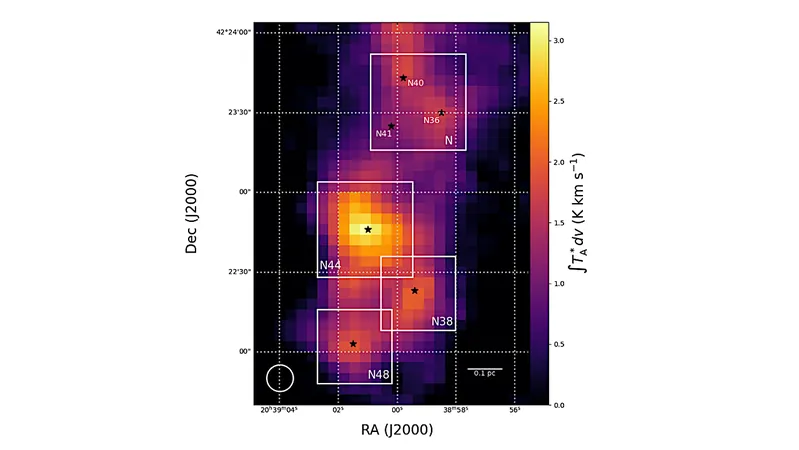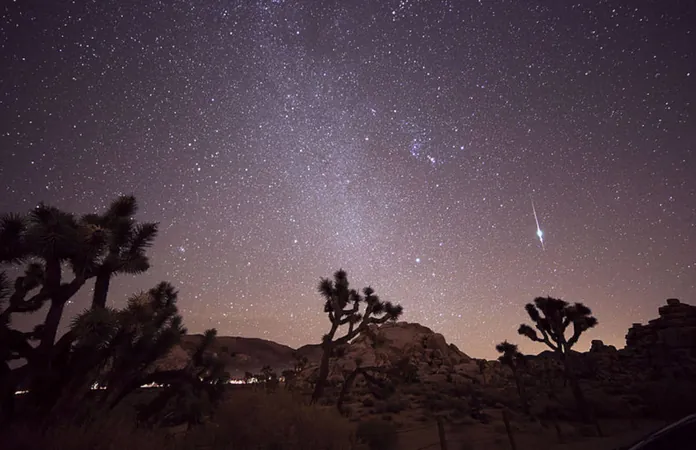
Unraveling the Secrets of Star Formation: Insights from the DR21(OH) Clump
2024-11-21
Author: Yu
Introduction
In the heart of the cosmos, star-forming regions are bustling hotspots teeming with a variety of molecular species that play vital roles in the process of star birth. A recent study focused on the DR21(OH)/N44 region has leveraged molecular transition lines from complex organic molecules to shed light on the physical and dynamical processes underlying high-mass star formation.
Research Methodology
Using the cutting-edge IRAM 30-m telescope and the 100-m Green Bank Telescope (GBT), researchers embarked on a comprehensive wide-band spectral survey, bringing forward important findings about molecules like CH3CCH (propyne), CH3OH (methanol), and H2CO (formaldehyde). Their goal? To decode the intricate large-scale structure and environmental conditions surrounding these high-mass formation regions.
Analysis Techniques
The research utilized a sophisticated multi-component local thermodynamic equilibrium model to analyze the physical environment near DR21(OH) and its surrounding dense clumps. A follow-up study using radiative transfer code specifically for CH3OH investigated its non-LTE behavior, shining a light on molecular dynamics that traditional approaches might overlook. This layered analysis aimed to unravel the formation mechanisms behind these significant molecules.
Key Discoveries
Among the team's discoveries were distinct "warm" and "cold" components associated with the dense regions known as MM1 and MM2, as well as a notable broad outflow component. Additionally, the study mapped warm and cold components across several other dense clumps, including N40, N36, N41, N38, and N48. Remarkably, it was established that thermal processes could account for the observed levels of H2CO and CH3CCH, whereas CH3OH required non-thermal explanations, hinting at complex underlying chemistry.
Integration of Findings
By employing a unique combination of wide-band mapping observations and chemical modeling across varying temperatures and velocities, the researchers successfully integrated the micro-level behavior of molecules with the overall clump-scale characteristics, which bridge the relationship between star-forming cores and their parental clouds. The findings revealed several warm components ranging from 20 to 80 K aligned with previously identified cores and outflows, illuminating the intricate web of molecular interactions that nurture star formation.
Conclusion
As we delve deeper into cosmic chemistry, studies like this uncover the dynamic and intricate environment that shapes our universe. The implications of these findings stretch far beyond DR21(OH), providing a promising glimpse into how stars, and indeed our own solar system, emerged from the primordial gas and dust of the cosmos. Stay tuned for more intriguing developments in the realm of astrophysical research, as we continue to unravel the mysteries of the stars!





 Brasil (PT)
Brasil (PT)
 Canada (EN)
Canada (EN)
 Chile (ES)
Chile (ES)
 España (ES)
España (ES)
 France (FR)
France (FR)
 Hong Kong (EN)
Hong Kong (EN)
 Italia (IT)
Italia (IT)
 日本 (JA)
日本 (JA)
 Magyarország (HU)
Magyarország (HU)
 Norge (NO)
Norge (NO)
 Polska (PL)
Polska (PL)
 Schweiz (DE)
Schweiz (DE)
 Singapore (EN)
Singapore (EN)
 Sverige (SV)
Sverige (SV)
 Suomi (FI)
Suomi (FI)
 Türkiye (TR)
Türkiye (TR)